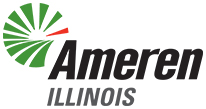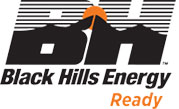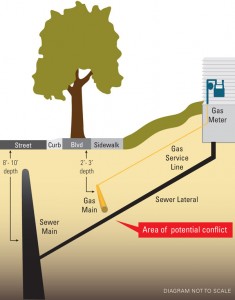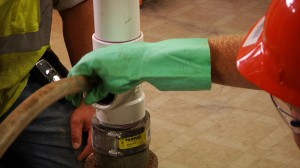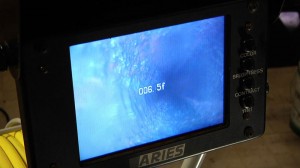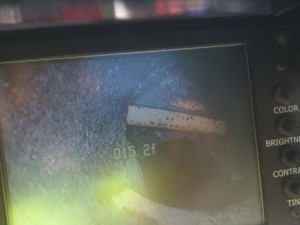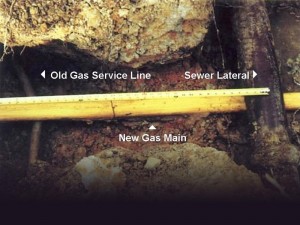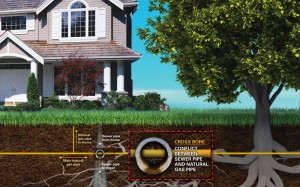Know the Risk of Cross-Bore Encounters
A cross bore occurs when underground natural gas pipes or other utility lines are inadvertently installed through sewer or septic pipes. A cross bore through a sewer lateral will impede the flow of sewage and eventually lead to a blockage. If you attempt to remove the blockage with mechanical equipment, you risk cutting a live natural gas or electric utility line, threatening lives and property with fire, explosion, or serious electrical shock.
Please remember, Call Before You Clear!
Video
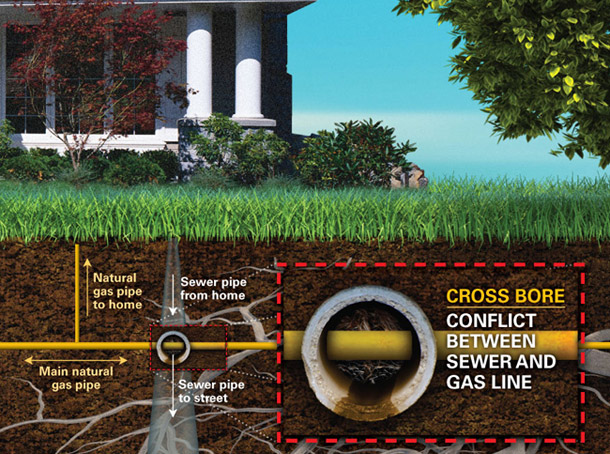
Participating utilities

AVAILABLE IN: OHIO
800-344-4077
AVAILABLE IN: PENNSYLVANIA
888-460-4332
AVAILABLE IN: MARYLAND
888-460-4332
AVAILABLE IN: VIRGINIA
800-544-5606
AVAILABLE IN: KENTUCKY
800-432-9515
When to call
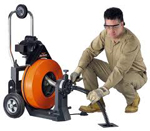 Ifyour sewer is backed up or slow to drain, your first call should be to the natural gas utility serving the area. Why? There is a possibility that a natural gas pipe could have been inadvertently installed through your sewer pipe and the mechanical equipment used to unclog sewer pipes can penetrate the natural gas pipe and lead to the dangerous release of natural gas.
As long as a natural gas pipe is not penetrated, it poses no safety hazard. However, if you are having troubles with your sewer, or think you have a blockage, please call the natural gas utility serving the area first before anyone attempts to clear the sewer pipe.
Ifyour sewer is backed up or slow to drain, your first call should be to the natural gas utility serving the area. Why? There is a possibility that a natural gas pipe could have been inadvertently installed through your sewer pipe and the mechanical equipment used to unclog sewer pipes can penetrate the natural gas pipe and lead to the dangerous release of natural gas.
As long as a natural gas pipe is not penetrated, it poses no safety hazard. However, if you are having troubles with your sewer, or think you have a blockage, please call the natural gas utility serving the area first before anyone attempts to clear the sewer pipe. Don't Flush Wipes. Period.
Flushing any wipe can increase the risk of a drain clog and a cross-bore encounter.
“Flushables” or “septic-safe” wipes bind with fats and oils, clogging local sewer systems and harming home plumbing. Disinfecting wipes were never intended to be flushed and are compounding this problem. The result is more drain cleaning in laterals, which heightens the risk of plumbers encountering existing cross bores. (A cross bore occurs when underground natural gas pipes have been inadvertently installed through sewer or septic pipes.)
Dispose of disinfecting wipes in waste bins instead of flushing them, and encourage your family, friends and customers to do the same. Spread the word!
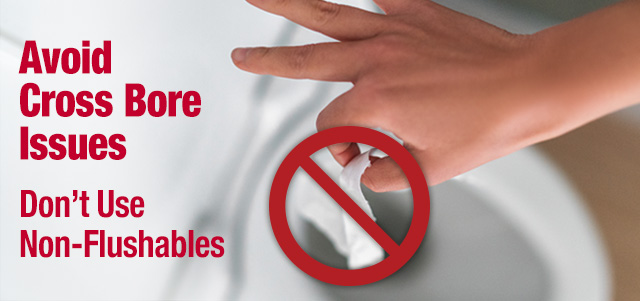
Frequently asked questions
Why WOULD A UTILITY NOT HAVE KNOWN THE NATURAL GAS PIPE INTERSECTED THE SEWER OR SEPTIC PIPE?
Many utilities use underground “horizontal directional digging” to install natural gas pipes underground beneath streets, driveways, and mature trees to minimize damage. This approach is commonly used in the industry because it involves significantly less environmental impacts and disruption than open trench digging. However, because many vintage sewer and septic lines are made of clay and contain no tracer wire they are not “locatable” (where they can be identified with above ground locating devices) and a utility may have come in contact with it without knowing.WHAT SHOULD I DO IF I HAVE A SEWER OR SEPTIC CLOG?
If you are having troubles with your sewer or septic, or think you have a blockage, make sure the natural gas utility serving the area is contacted first (either by you or your sewer/septic cleaner) before anyone attempts to clear the sewer or septic pipe. The natural gas utility will examine its records to determine if any potential conflicts exist between its natural gas pipes and whether an in-line camera inspection may be needed.WHAT IF AN IN-LINE CAMERA INSPECTION IS NEEDED?
Participating utilities work with professionally trained sewer and septic camera contractors who can be sent to your location to complete an inspection. The contractor uses a special camera that goes inside the sewer or septic pipe to identify any conflicts or “cross bores” with underground natural gas lines. There is no charge for this service.HOW SOON AHEAD SHOULD I CALL?
If you have a blockage or are scheduled to have your sewer or septic pipe cleaned, make sure the natural gas utility serving the area is contacted first (either by you or your sewer/septic cleaner) to determine if an in-line camera inspection is necessary. There is no charge for this service.HOW WOULD I KNOW IF A NATURAL GAS PIPE WAS PENETRATED WHILE CLEANING A SEWER OR SEPTIC PIPE?
➔ A natural gas odor at the clean out or inside the building served by the sewer or septic line.➔ Bubbles rising through standing water or in the toilet bowl.
If these signals are present:
➔ Stop what you’re doing and have everyone immediately evacuate the premises
➔ Leave the doors open
➔ Do not turn on or off any light switches, or use other sources of ignition
➔ From a safe distance, call 9-1-1 for immediate assistance
WHAT IF I SENSE OR SEE, BUT DO NOT PENETRATE, A NATURAL GAS PIPE?
Call the natural gas utility serving the area for immediate assistance to ensure that the gas pipe has not been damaged.Photos
The camera monitor displays in full color any cross bores between a natural gas pipe and sewer or septic pipe. Using this information, the drain cleaner, plumber or home owner should immediately contact the natural gas utility serving the area to notify them of the cross bore and not attempt to clear.



